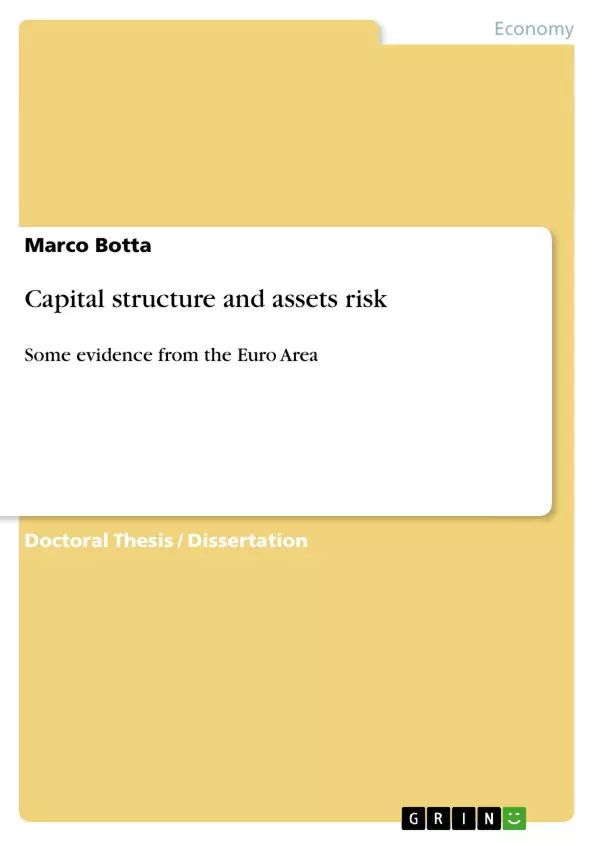Using a sample of non-financial listed firms located in the Euro area, I investigate the determinants of capital structure choices. In line with the traditional theoretical approach, I use a market-value measure of leverage, estimated with the Black-Scholes-Merton model. In the cross-section regressions for firm leverage I find that some variables have similar effects across countries, while others may play a different role; risk, measured as the volatility of the market enterprise value, is the best predictor of observed leverage ratios. Risk, and asymmetric information about risk, make debt less attractive, because of higher expected bankruptcy costs, lower expected debt tax shield and higher agency costs. National environments are an important determinant of observed ratios; sector of activity is a relevant factor as well. The integration of Euro-area financial markets varies significantly depending on the market segment considered: money and inter-bank markets are highly integrated, corporate bond and equity markets show a clear path of increasing integration, retail banking markets are much less integrated. Fiscal and bankruptcy rules differ across the twelve countries; the economic background varies as well.
Inhaltsverzeichnis (Table of Contents)
- Introduction
- Review of the literature
- The theoretical literature
- The irrelevance proposition
- The role of corporate and personal taxes.
- Bankruptcy costs and the trade-off theory
- Agency costs and firms financing
- The empirical literature
- The tax advantage of debt.
- Costs of financial distress
- Empirical evidence on capital structure
- The theoretical literature
- Empirical findings
- The dataset
- Data sources
- The relevant variables
- Econometric analysis.
- The methodology
- The results
- Results with market-value debt ratios.
- Results with book-value debt ratios.
- Sectoral versus country regressions
- Relationships with the existing literature and conclusions
- The dataset
- National environments and the role of risk
- Financial markets integration in the Euro area
- The conditions of local financial markets
- The economic background
- Bankruptcy laws and the quality of governance
- The effects of asset value volatility on financing costs
- Conclusions
Zielsetzung und Themenschwerpunkte (Objectives and Key Themes)
This work investigates the factors that influence a company's decision to use debt financing, specifically focusing on non-financial firms listed in the Euro area. Using the Black-Scholes-Merton model, the study employs a market-value measure of leverage to analyze the impact of various factors on capital structure choices. The key themes explored in the text are:- The relationship between risk and leverage: The study examines how risk, including both volatility and asymmetric information, influences a firm's decision to use debt financing.
- The impact of national environments: The research investigates how factors such as financial market integration, fiscal and bankruptcy rules, and economic background contribute to differences in capital structure across Euro area countries.
- The role of sector of activity: The study explores the influence of industry-specific factors on capital structure choices.
- The interplay between financial markets and leverage: The text analyzes the integration of Euro area financial markets and its implications for corporate financing decisions.
- The link between asset value volatility and financing costs: The research investigates the effect of asset value fluctuations on the cost of debt financing.
Zusammenfassung der Kapitel (Chapter Summaries)
The introduction lays out the study's objectives, focusing on the determinants of capital structure choices for non-financial firms within the Euro area. It also outlines the theoretical and empirical frameworks that underpin the analysis. Chapter 1 delves into the literature on capital structure, reviewing both the theoretical and empirical perspectives. It examines various models, including the irrelevance proposition, the role of corporate and personal taxes, the trade-off theory, and agency cost considerations. The chapter also explores empirical evidence on the tax advantage of debt, the costs of financial distress, and previous research on capital structure. Chapter 2 presents the empirical findings of the study. It describes the data sources and variables used, and outlines the econometric methodology employed. The chapter then presents results from both market-value and book-value debt ratios, discussing the impact of various factors on leverage decisions. It concludes by analyzing the relationships between sectoral and country-level regressions. Chapter 3 focuses on national environments and their role in shaping capital structure choices. It investigates the integration of Euro area financial markets, analyzing the conditions of local financial markets, economic background, bankruptcy laws, and the quality of governance. The chapter also explores the effects of asset value volatility on financing costs.Schlüsselwörter (Keywords)
The core keywords and topics of this work include capital structure, leverage, debt financing, Euro area, non-financial firms, risk, asymmetric information, bankruptcy costs, agency costs, national environments, financial market integration, fiscal and bankruptcy rules, economic background, sector of activity, asset value volatility, and financing costs.- Quote paper
- PhD Marco Botta (Author), 2007, Capital structure and assets risk, Munich, GRIN Verlag, https://www.grin.com/document/273880



